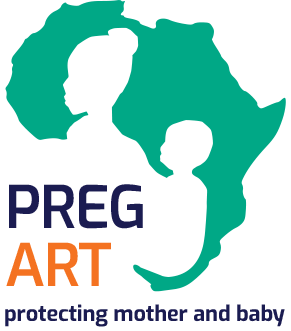THE PROJECT
PREGART is a multi-national clinical trial aimed at identifying optimal antiretroviral treatment regimen to prevent mother to child transmission of HIV by comparing the efficacy and safety and of two newly introduced first line Antiretroviral treatment regimens (ART) among 1156 HIV infected pregnant women and infant pairs in Ethiopia and Uganda.
The PREGART project is funded by the European and Developing Countries Clinical Trials Partnership (EDCTP-2): Grant Agreement number RIA2017MC-2009.
The PREGART consortium consist of two European and two African partner organizations: Hawassa University (HU) – Ethiopia (coordinator), Makerere University – Uganda, Karolinska Institutet – Sweden, and Italian National Institute of Health (Istituto Superiore di Sanità) – Italy.
Current treatment and hypothesis of intervention
The use of safe and effective antiretroviral drugs during pregnancy and breastfeeding is key to achieving the elimination of mother-to-child transmission (MTCT) by 2030.
In 2016, the WHO guidelines recommended the use of Tenofovir (TDF), Lamivudine (3TC) and standard dose of Efavirenz 600mg/day (EFV600) as first line drugs for all adults including pregnant and breastfeeding women living with HIV.
Recently WHO revised the treatment guideline and introduced two antiretroviral treatment (ART) regimens; Dolutegravir (DTG) with TDF and 3TC as the preferred, and Low dose of efavirenz EFV 400mg/day (EFV400) with TDF and 3TC as an alternative first line ART regimen for adults including pregnant and breastfeeding women. This recommendation is based on findings from previous studies showing better efficacy and/or tolerability of DTG or EFV400 than EFV600 based ART regimens in adult patients. However, safety and efficacy data from pregnant women are scarce.
According to WHO, data on the efficacy (PMTCT, viral suppression during pregnancy, at delivery, and postpartum), safety (adverse pregnancy outcomes, short- and long-term ART-associated toxicities including metabolic derangements, weight gain etc.), and the impact of intrauterine exposure to antiretroviral drugs on infant/child neurocognitive developments remains a priority research gap. The PREGART project aims to address all these knowledge gaps by comparing the safety and efficacy parameters of two first line ART regimens (DTG versus EFV400) in 1156 mother-infant pairs.
The trial
The study design is a multicenter, interventional, parallel assignment, and controlled two-arm non-inferiority randomized clinical trial being conducted in Ethiopia and Uganda (PACTR201909810587438).
The safety and efficacy of DTG and EFV400 containing cART regimens will be compared for their safety and efficacy during pregnancy and breastfeeding: TDF +3TC+DTG (Standard arm) which is a preferred first line PMTCT regimen, TDF + 3TC + EFV400 (Treatment arm) that is an alternative first line PMTCT regimen.
PREGART will provide comprehensive and statistically powered evidence on the maternal and infant safety and efficacy of DTG and EFV 400mg containing cART.
Study hypothesis
To show that the combination EFV400, TDF, 3TC is non-inferior to DTG based ART regimen during pregnancy and breastfeeding.
General objectives
The main aim of the PREGART clinical trial project is to identify safe and efficacious cART regimens for HIV infected pregnant and breastfeeding women. PREGART will provide evidence-based recommendations for national, regional, and international policy makers including WHO on optimal ART regimen for pregnant and breastfeeding women living with HIV.
Primary objectives
- To compare the efficacy of EFV400 based combination antiretroviral treatment (cART) regimen with a DTG containing cART regimen among pregnant women at delivery.
Primary end point 1 – Proportion of HIV infected pregnant women on cART who achieved virological suppression at delivery (defined as <50 copies/mL).
- To compare the safety of DTG and EFV400 containing cART regimens among HIV infected pregnant and breastfeeding women.
Primary end point 2 – The rate of composite adverse pregnancy outcomes (any one of spontaneous abortion, stillbirth, preterm birth, END, SGA etc.)
Secondary objectives
- To compare the rate of mother to child HIV transmission (MTCT) at birth, 6, 24, 48 and 72 weeks of infant age.
- To compare the rate of viral suppression during pregnancy and at 6, 24 and 48 weeks postpartum
- To compare the rate of any severe adverse event (SAE) occurred during pregnancy and breastfeeding.
- To compare the rate of treatment- associated dyslipidemia, hepatotoxicity, neuropsychiatric adverse events, infant neurocognitive development, infant growth, hyperglycemia, drug resistance.
To investigate the Pharmacogenetics and pharmacokinetics of EFV and DTG and its association with treatment outcom
